To anyone observing the rise of China – and more of us should be – it has been evident for well over a decade that Western financial media have descended into self parody on the subject. The outlets best known to me are Business Insider, The Economist and to lesser extent Investment News. All cry wolf, year in/year out, about a Chinese economy on the verge of collapse. 1
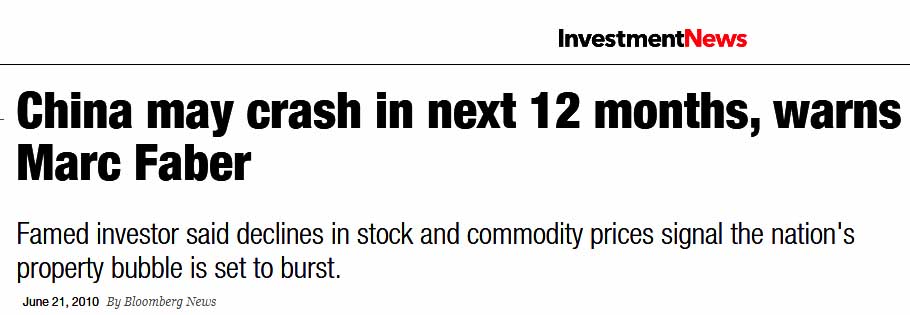
2010: a “famed investor” is quoted in the kicker as predicting (correctly) a property bubble set to burst. This is translated, in header and body, into general economic collapse. How did that prediction work out?
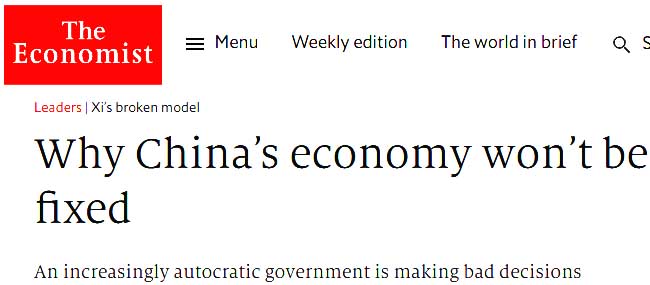
The Economist routinely pairs inaccurate but perennial predictions of China’s imminent collapse with “advice” that Beijing do as the West does, and let capitalists control the state instead of the other way round.

Where would we be without those “market experts”? They were so bang on the nail in the run up to Lehman Brothers and all that ensued …
I see such media as the ‘economic’ wing of a more general Sinophobic assault by all sections of our systemically corrupt corporate media …
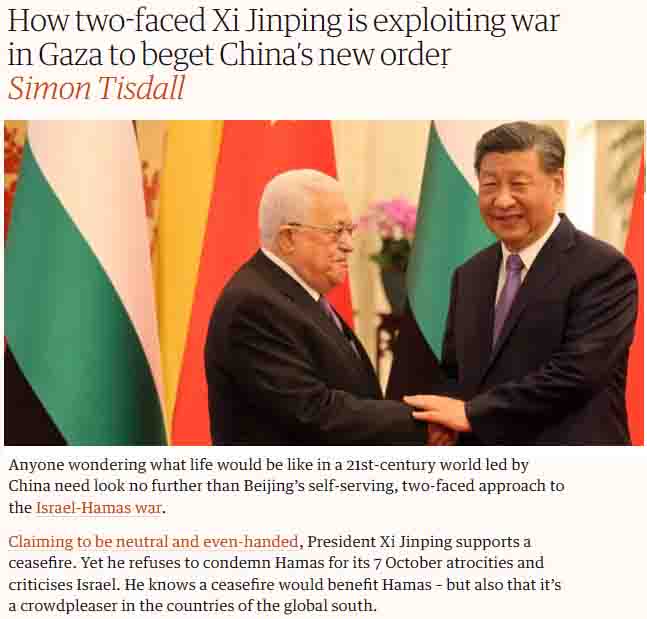
Observer, 11/11/23. See also, The whataboutery of Simon Tisdall 2
… driven by the fear, haunting Western strategists for 500 years, of a Eurasia uniting at both its eastern and western poles to threaten Western supremacy. This fear is justified in the sense that Eurasia is united – thanks in no small part to Western policies, Washington’s especially – and is rising.
But it is unjustified in the sense that the Western ruling elites who most fear Eurasia rising have, as ever, conflated their own interests with those of their citizens. 3 In this they’ve enjoyed great success. I don’t doubt that a pugnacious know-nothing like Simon Tisdall believes every word of the fact-defiant but empire-serving guff he serves up.
Those elites have also done what psychologists call projection. Because that half-millennium of Western ascendance has been accompanied by history’s darkest chapters – quantitatively if not qualitatively – and driven by zero-sum avarice, they assume a Eurasia rising will behave as they did and still do.

It ain’t necessarily so.
As did the white rulers of apartheid South Africa, and as do the Zionist rulers of apartheid Israel, those elites see their own reflection – if I’m charitable enough to discount flat-out mendacity – in those they seek to subjugate, and by that fact fear. Take the way Western fingers point, long after the charge has been thoroughly debunked, to China’s loans to the global south as debt traps. Since this is just what the West has done and – with a weakening hand – continues to do, it may be beyond the wit of its rented thinkers and mouthpieces to view with an open-mind the very different economic model of co-operation and win-win on offer from China rising, BRICS and BRI.
This subject has been brilliantly explored by political economist, debt specialist and Sinophile, Michael Hudson. But today saw the posting of a useful short piece by the Marxist economist, Michael Roberts; its starting point the meeting yesterday, November 15, between Joe Biden and Xi Jinping.
Given my opening assertion that “more of us should be” observing the rise of China, Mr Roberts – featured in previous posts – gets my vote today. Like me, and for that matter Michael Hudson, he is not uncritical of Beijing, and for the same reason – fear of it losing control of its capitalists to allow the runaway rentier forms so disastrous in the West.
But those ultra-leftists who assure us that this has already occurred have a good many things in common with their (neo) liberal mirror opposites. One is that they pay insufficient attention to China’s real economy.
Over to Mr Roberts.
Xi meets Biden
US President Joe Biden and Chinese President Xi Jinping met yesterday during the Asia-Pacific Economic Cooperation (APEC) summit in San Francisco.
This was the only second face-to-face meeting during the Biden presidency. It seems the aim was to clarify just how close the US and China are to conflict over Taiwan and other security issues, as well as trying to establish some semblance of trade progress after years of US moves to reduce China’s rise in hi tech and other products (EVs) that threaten US hegemony. Indeed, Xi was also meeting US business leaders to try and reassure them that they can invest in China, despite recent moves by the Chinese CP leaders to tighten controls on the capitalist sector.
It does not appear much came out of the meeting apart from agreeing not to attack each other ‘by mistake’. But while the leaders ‘talked turkey’, the economic reality is that US efforts to strangle the Chinese economy are not working. Western ‘experts’ continue their never-ending message that China is close to a debt collapse; China’s property market is imploding; and above all, China’s previous phenomenal growth is now over and the economy since COVID is grinding to a halt and will end up like Japan, stagnating in a sea of debt.
If this were really so, then Biden and American capital would have nothing to worry about – but they do worry and rightly so. Yes, China’s property bubble has burst and some very large private sector property developers are going bust. In previous posts, I have argued that it was a big mistake by the Chinese CP leaders to adopt the Western capitalist model for urban development. Instead of putting housing construction into the public sector to build homes at reasonable rents for the hundreds of millions of Chinese who have moved into the cities to work, the government allowed private developers (with billionaire owners) to do the job and now the result is a classic debt-driven bubble that has burst.
And yes, overall debt in the capitalist sector has rocketed. Now the government will be forced to liquidate many of these developers and/or ‘restructure’ their operations with state money. But this does not mean China is about to have deflationary crash. China’s net debt to GDP ratio (debt burden) is only 12% of the average in the G7 economies. The state holds huge financial assets; so it can easily manage this property slump.
The government has just announced that its new Central Financial Commission will take over from the People’s Bank and the existing financial regulator, the control of China’s financial private sector. The ‘Western experts’ decry this move because they think the market can better allocate investment than the state. “The temptation to intervene in capital and credit allocation, whether arising from risk or management failure, or from political directive, is likely to be elevated,” said perennial China sceptic, George Magnus. He added. “These features do not augur well for China’s financial stability or economic prospects.”
The point is that the Xi leadership no longer trust the Western-educated economists in the People’s Bank to regulate the private sector – the bank is a fortress of neo-classical pro-market economics. The bank’s economists would support Magnus’ approach to free up the finance sector – something so successful in Western economies! But the CP leaders still stop short of bringing these speculative financial and real estate speculators into public ownership (no doubt some leaders have personal links). Until they do, financial speculation will continue to distort the economy much more than any arbitrary policies of the party leaders.
The Chinese economy is not diving into a recession. The IMF has just forecast that China’s real GDP will rise by 5.4% this year – and that’s an upgrade from its previous forecast. The housing market may be struggling, but productive industrial construction is booming. China has already built enough solar panel factories to meet all demand in the world. It has built enough auto factories to make every car sold in China, Europe and the US. By the end of next year, it will have built in just five years as many petrochemical factories that Europe and the rest of Asia have now.
And take hi-speed rail and infrastructure projects. Back in the US, Biden makes much of his infrastructure program after decades of decline and neglect in US transportation facilities. But that’s nothing to the rapid expansion of hi-speed rail and other transport projects that now have linked up the vast expanse of China’s regions. Compare this to the state of infrastructure in the San Francisco area as Xi visits.
Ah, but you see, China’s economy is seriously ‘imbalanced’. There is ‘too much’ investment in such projects and not enough handouts to the people to spend on consumer goods like I-phones or services like tourism and restaurants. China cannot grow any more unless it switches households from saving to spending and investment to consumption. The old state-led investment and export model is dying. China will now end up like Japan, stagnating with near zero growth and a falling population.
I have pointed out the nonsense of this view on several occasions. China’s growth has been based on a high rate of productive investment – at least until the unproductive capitalist property development sector came overloaded with debt.
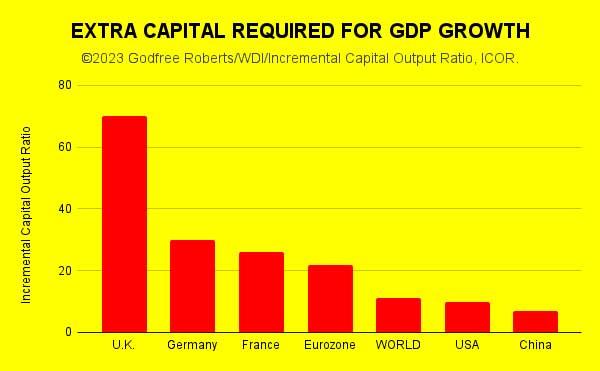
But high investment does not mean low consumption growth – on the contrary, investment leads to more production, more jobs and then more incomes and consumption. China’s supposedly low consumption ratio to GDP compared to the highly successful Western capitalist economies is accompanied by a much faster growth in household spending. Indeed, retail sales rose 7.6% yoy in October – not suggesting an entirely weak consumer. China’s workers may not have any say in what their government does, but nevertheless, their wages are still rising faster than anywhere else in Asia.
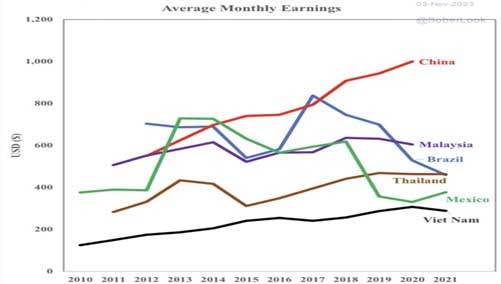
And those wage rises are not being eaten away by inflation as has happened in the last few years in the rest of the G20 economies. China’s inflation rate is near zero while inflation, despite recent falls, in the US and Europe is several times higher – indeed US workers have seen prices rise by 17% since COVID.
The Western mainstream economists proclaim China’s ‘disappointing’ economic slowdown (real GDP growth 5.4% and forecast 4.5% next year), but they say little about Japan. Japan is dropping into stagnation and even slump. In Q3 2203, real GDP fell 2.1% at an annualised rate (the measure US economists use to bolster the US rate); consumer spending is stagnating and business investment’s decline is accelerating.

Japan: real GDP growth (annualised rate) %
Japan is joining much of the Eurozone, the UK, Canada, Sweden, New Zealand etc in contraction this coming year.
And if Biden is hoping that the upcoming presidential election in Taiwan will lead to a victory for the pro-independence candidate from the Democrat party, then he could be in for a surprise. It seems that the two anti-independence, pro-China parties, the Kuomintang and People’s Party, are planning to run a single candidate for the presidency and current polls show that such a candidate would win. So that could mean a pro-China president in Taiwan next year.
Speaking as one who brought daughters into this world, and who has good friends their age in Taiwan, that last outcome would be most welcome. The parallels with Ukraine are terrifying. As is the fact that here the stakes are even higher.
And the opportunities – not for septuagenarians like me but for the youth of West and Global South alike – in a multipolar world, ushered into being by the refusal of China and Russia to submit to the US hegemon, allow me a modicum of hope for humanity.
* * *
- Given that capitalism in its Western hyper-financialised forms runs on herd psychology, the doomsaying of Western financial media is more than denialism. It can also be seen as aimed at deterring investors attracted by the returns promised by BRI.
- I don’t know whether it is Simon Tisdall’s dishonesty, or that of the Observer editor who chose his lead image, but that image depicts Xi with PLO Chair Mahmoud Abbas whereas the article has nine instantiations of “Hamas”; none of “PLO”. Hamas, recall, was boosted by Israel to weaken the PLO, divide and rule style. Nor should we forget that October 7 took the West Bank no less by surprise and – given Cairo’s claim to have forewarned Tel Aviv of “something big” afoot – maybe more so than it did the IDF. (The Egyptian claim is plausible given Cairo’s decades of hostility to the Muslim Brotherhood from which Hamas came into being.) Such crude propaganda, or at best editorial sloppiness, leverages the way Westerners poorly informed will skim-read the piece before subliminally concluding they’ve seen Xi with Hamas. A similar leveraging of unconscious association was at play in media coverage of the March for Palestine in London the day the Simon Tisdall piece ran. Reports of violence by far right opponents of the march, and of consequent arrests, were framed in so loose a way as to ensure that the less alert viewer or reader would not differentiate fascist goon from peaceful marcher. Nor need we assume conscious bias on the part of news teams. As much consumers as suppliers of propaganda – and no more given to critical thinking and reflection than their audiences – those news gatherers and presenters exemplify, as do the more blatant ravings of Mr Tisdall, both the subtle and the gross ways in which dominant ideology operates.
- For an unusually transparent example of how ruling elites conflate their interests with those of their citizens, look no further than Europe’s economic suicide over Ukraine.
